Environmental Engineering Reference
In-Depth Information
Wind speed
Figure 5.24
Wind turbine power curve
change in wind speed will have no appreciable affect on wind power production.
Similarly, if the wind speed is high, with most wind turbines operating close to
rated output, then a small variation in wind speed will also cause minimal change in
wind power production, since, depending on design, pitch or stall regulation of the
turbine blades will ensure that equipment ratings are not exceeded. However, at
midrange wind speeds, then the cubic relationship between wind speed and power
production implies that a small variation in wind speed will cause a relatively large
change in electrical output.
Geographical dispersion again provides a smoothing effect, so, for example, in
Ireland only a maximum 8 per cent variation in output could be expected within a
1 hour period (Figure 5.18). Similarly, in the United Kingdom, variations less than
2.5 per cent of the total installed wind capacity are most probable from one hour to
the next - 20 per cent changes in hourly output are only likely to happen once per year
(ECI, 2005). As the area under investigation further increases in size, the variability
tends to decrease. In Germany, for example, the maximum hourly variation in output
rarely (
<
0.01 per cent) exceeds 20 per cent of the wind farm capacity, with a standard
deviation for these deviations of only 3 per cent (Gardner
et al.
, 2003). For the four
Nordic countries (Norway, Sweden, Finland and eastern Denmark - forming part
of the Nordpool system) the largest hourly changes will decrease to approximately
11 per cent of the installed capacity, although for 98 per cent of the time the variation
decreases to 5 per cent of installed capacity (Holttinen, 2005a).
Should wind power penetration reach 5-10 per cent, the wind variations
become comparable with random, short-term demand variations (see Figure 5.20).
Concern may arise not only from the magnitude of the variability, but also the rate
of change, and hence the dynamic requirements placed upon the conventional
generation (Figure 5.25). There will thus be a requirement for extra regulating/
secondary reserve - typically somewhere between 2 and 10 per cent of the installed
wind power capacity for a 10 per cent wind penetration (Holttinen, 2005b; ILEX and
Strbac, 2002; Parsons
et al.
, 2004; SEI, 2004). For example, in the United Kingdom,
assuming a 10 per cent wind penetration, reserves equivalent to 3-6 per cent of
the wind capacity were deemed necessary (ILEX and Strbac, 2002). This figure rose










































Search WWH ::

Custom Search